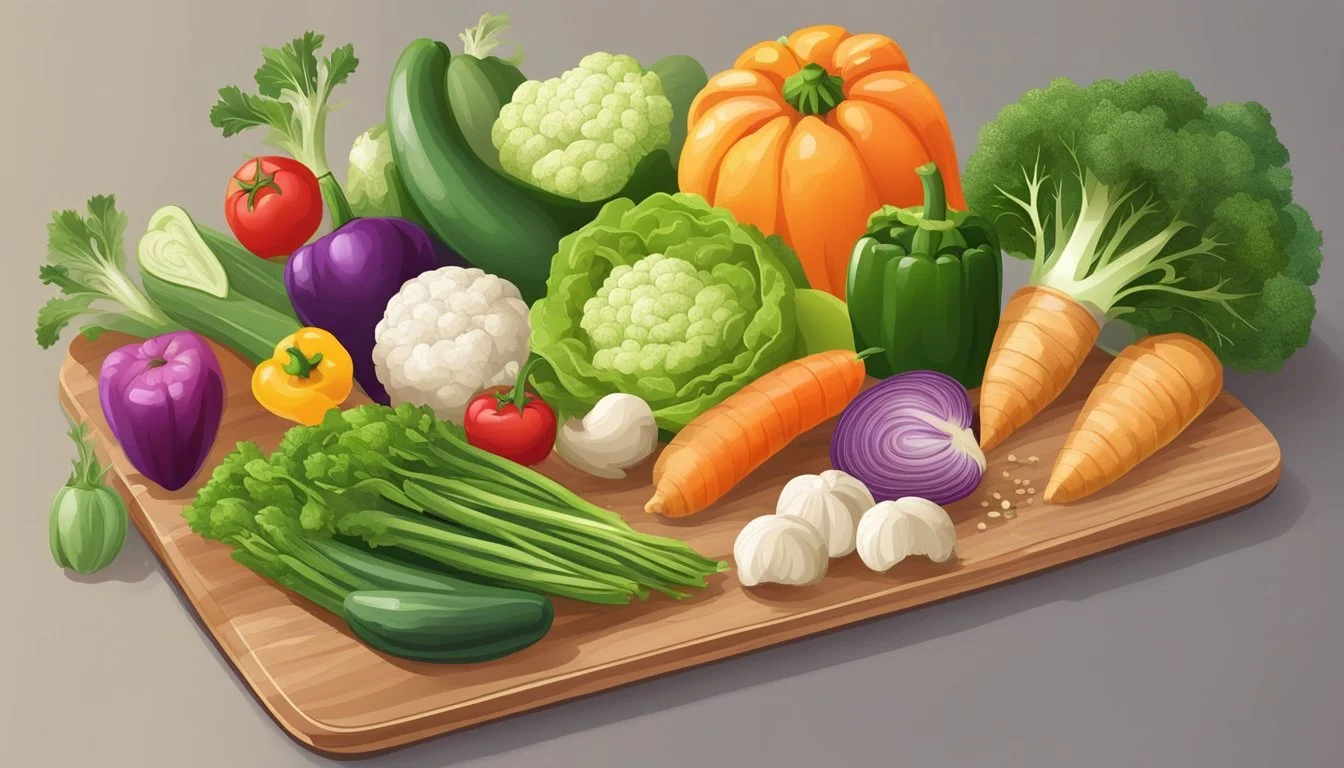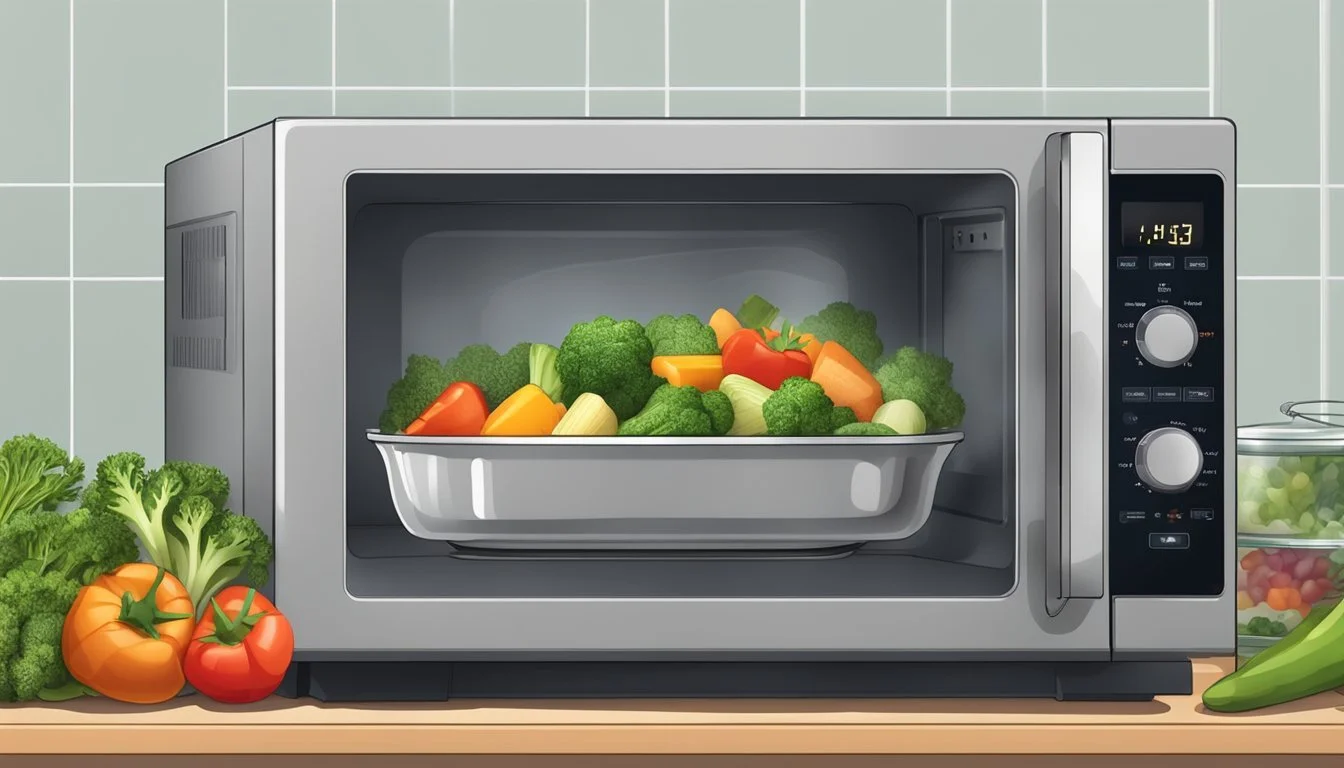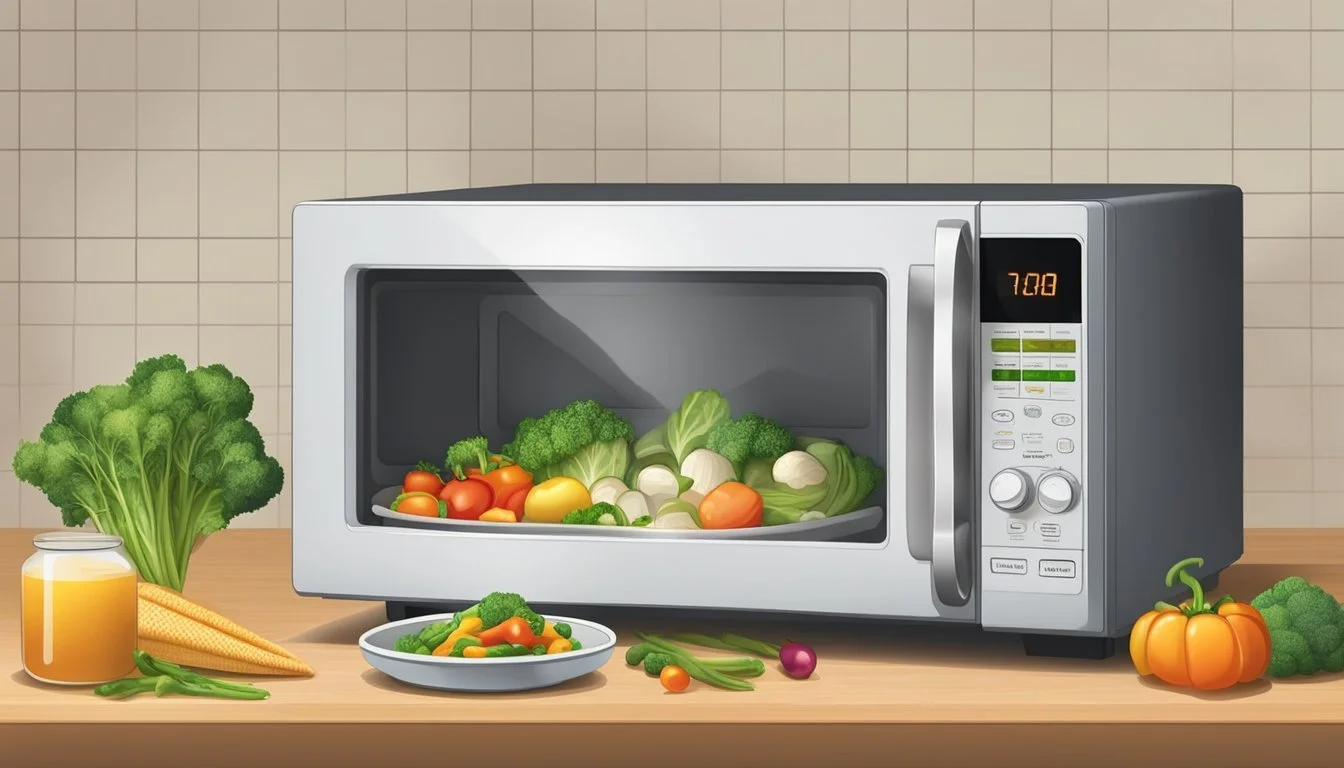How to Reheat Gluten-Free Mixed Vegetables
Best Methods for Fresh Taste
Reheating gluten-free mixed vegetables can be a challenge, especially if you want to maintain their texture and flavor. To effectively reheat mixed vegetables without compromising their taste or consistency, consider using an oven reheating method. Preheat your oven and place the vegetables on a baking sheet, cover with foil to trap moisture, and heat for about 10-15 minutes. This method helps in retaining the vegetables' crispness and prevents them from drying out.
For those looking for a quicker option, sautéing is an excellent alternative. Add a bit of olive oil to a hot pan, toss in your vegetables, and heat them for a few minutes while stirring occasionally. This technique not only warms the vegetables but also enhances their taste with a slight touch of added flavor from the oil.
Regardless of the method you choose, ensuring the vegetables are stored correctly before reheating is essential. Cool them at room temperature, store them in an airtight container, and refrigerate to keep them fresh. By following these steps, you can enjoy the deliciousness of your gluten-free mixed vegetables all over again.
The Importance of Gluten-Free Diets
A gluten-free diet excludes gluten, a protein found in wheat, barley, and rye. This diet is essential for individuals with celiac disease, an autoimmune disorder where gluten intake damages the small intestine.
Beyond celiac disease, some people experience non-celiac gluten sensitivity where gluten causes discomfort without intestinal damage. For them, avoiding gluten can improve quality of life.
Benefits for Celiac Disease Patients:
Gut Healing: A strict gluten-free diet allows the intestines to heal, reducing symptoms like diarrhea, bloating, and fatigue.
Improved Nutrition: Proper absorption of nutrients such as iron, calcium, and folate is restored.
Nutritional Profile:
Healthy Choices: Lean meats, fish, fruits, vegetables, eggs, and dairy products are naturally gluten-free and nutritious.
High Fiber: Foods like beans, seeds, and legumes provide essential dietary fiber.
Food Group Gluten-Free Options Grains Amaranth, Buckwheat, Corn Protein Lean meats, Fish, Poultry Dairy Most low-fat dairy products Legumes Beans, Lentils, Chickpeas Vegetables All fresh, unprocessed options Fruits All fresh, unprocessed options
Celiac disease not only affects digestion but can lead to serious health issues if untreated. A gluten-free diet is the primary treatment to manage symptoms and prevent complications. By choosing naturally gluten-free foods, individuals can maintain a balanced and nutritious diet without compromising their health.
Selecting the Right Gluten-Free Vegetables
When choosing gluten-free vegetables, it's crucial to focus on natural, whole veggies. These retain their nutritional integrity and are free from gluten contamination.
Opt for vibrant-colored vegetables like carrots and bell peppers. Carrots provide ample vitamin A and are excellent for stir-fries. Bell peppers, rich in vitamin C, add a sweet crunch to any mixed vegetable dish.
Broccoli and cauliflower are versatile options. Roast them with a drizzle of olive oil and a sprinkle of garlic for a tasty side. Both these vegetables are high in fiber and antioxidants.
Include leafy greens like spinach. Spinach is loaded with nutrients and can be quickly sautéed or added to mixed vegetable dishes. Asparagus is another great choice. It offers a unique flavor and is rich in vitamins and minerals.
Mushrooms and onions are also excellent for adding depth to any vegetable medley. Mushrooms bring a umami flavor while onions add a sweet, pungent kick when caramelized.
Zucchini and squash are perfect for adding variety in texture and color. They cook quickly and blend well with other vegetables. Green beans, peas, and corn are convenient options, especially as frozen vegetables. These can be easily added to your mix for extra fiber and nutrients.
Brussels sprouts and tomatoes are ideal for roasting. Brussels sprouts become crispy and flavorful, while tomatoes add a rich, savory taste that enhances the overall dish.
Remember to always read labels if you’re purchasing pre-packaged or frozen vegetables to ensure they are certified gluten-free. These simple tips will help you select the best gluten-free vegetables for your meals.
Preparation Tips for Gluten-Free Vegetables
To ensure your gluten-free mixed vegetables are delicious and safe, start by choosing fresh ingredients. Select carrots, bell peppers, onions, and garlic. Chop the vegetables evenly for consistent cooking.
Herbs add flavor without gluten. Popular choices include thyme, rosemary, and basil. Mix these with your vegetables.
For an easy recipe, coat the chopped vegetables lightly with olive oil, salt, and pepper. Toss them on a baking sheet to ensure even distribution.
Ensure all utensils and surfaces used are free from gluten contamination. Rinse and clean everything thoroughly before starting.
Consider adding dried herbs along with fresh ones. This can enhance the flavor profile of your dish without introducing gluten. Add these during the tossing process.
Freshness is key. Use the vegetables within a day or two of purchase for the best flavor and texture.
For those who love garlic, use either fresh cloves or dried garlic powder. Mince the fresh garlic finely and toss it with the vegetables before roasting.
Following these tips will help you prepare a flavorful, gluten-free vegetable dish that everyone can enjoy.
Proper Storage for Gluten-Free Vegetables
Storing gluten-free vegetables to maintain their freshness and quality involves a few simple but effective steps.
Refrigerator Storage
Place gluten-free vegetables in an airtight container to keep them from absorbing unwanted odors and moisture. Storing them in the refrigerator is key to preserving their freshness. It's important to keep the temperature consistent to prevent spoilage.
Freeze Roasted Vegetables
Freezing is a great option for longer storage. Before freezing, ensure that the roasted vegetables are completely cooled. Place them in a freezer-safe bag or airtight container. Label the container with the date to keep track of storage time. Frozen vegetables can be stored for up to three months.
Storage of Leftovers
When it comes to leftovers, transfer them to an airtight container promptly after cooling. Place them in the refrigerator if you plan to consume them within a few days. For longer storage, the freezer is the best option.
Storage Tips
Avoid Plastic Wrap: Plastic wrap can allow air and moisture in, causing the vegetables to spoil faster.
Use Glass Containers: Glass containers are excellent for maintaining the freshness and quality of the vegetables.
No Direct Sunlight: Keep stored containers away from direct sunlight as it can lead to spoilage.
These storage methods ensure that your gluten-free vegetables remain fresh, flavorful, and safe to eat.
Reheating Techniques for Gluten-Free Mixed Vegetables
Reheating gluten-free mixed vegetables requires careful techniques to ensure they stay tender, flavorful, and crisp. Various methods such as using an oven, stovetop, microwave, or air fryer can help achieve these results.
Using the Oven Method
Preheat the oven to 375°F (190°C).
Spread the vegetables on a baking sheet lined with parchment paper.
Cover with aluminum foil to trap moisture and heat evenly.
Bake for 10-15 minutes until the vegetables are warm and slightly crispy.
Vary the time based on the vegetable's thickness for the best results. Use a bit of olive oil to enhance flavor if needed.
Using the Stovetop Method
Heat a skillet over medium heat.
Add a small amount of olive oil or your preferred cooking oil.
Place the vegetables in the skillet and cook, stirring occasionally.
Cook for about 8-10 minutes until heated through. This method works well for retaining some crispness and can be adjusted by adding seasonings to taste.
Using the Microwave Method
Place the vegetables in a microwave-safe container.
Cover with a microwave-safe lid or damp paper towel.
Heat on high for 2-3 minutes.
Check and stir the vegetables halfway through. Adjust the time based on the wattage of your microwave and desired tenderness.
Using an Air Fryer
Preheat the air fryer to 350°F (175°C).
Spread the vegetables in the air fryer basket in a single layer.
Spray with a light coating of cooking oil for a crisp texture.
Cook for 5-8 minutes, shaking the basket halfway through to ensure even cooking. This method helps to keep the vegetables crisp and flavorful.
These methods ensure gluten-free mixed vegetables are reheated efficiently and maintain their delicious quality. Adjustments can be made based on specific vegetable types and personal preference.
Enhancing Flavor During Reheating
Adding butter can elevate the flavor profile of gluten-free mixed vegetables. Melt a small amount in a skillet before adding the vegetables.
Use fresh herbs like rosemary and thyme for aroma. Sprinkle them while reheating to infuse the veggies with their flavors.
A squeeze of lemon juice can brighten the taste. Add it just before serving.
Seasoning is crucial. Salt and pepper are basics, but consider adding red pepper flakes for a bit of heat.
Soy sauce can add umami. Drizzle a small amount during the last minute of reheating to ensure even coating.
Combining these seasonings in different ways can offer a variety of flavor experiences. For example:
Butter and thyme for a rich, herby taste
Lemon and rosemary for a fresh, zesty kick
Soy sauce and red pepper flakes for a savory, spicy twist
Complementary Gluten-Free Side Dishes
Cauliflower Rice: This popular side dish is both gluten-free and low in carbs. It can be flavored with herbs and spices or combined with other vegetables for a nutritious and tasty addition to any meal.
Sweet Potato Fries: Oven-baked sweet potato fries make a fantastic gluten-free option. Paired with an avocado dip, they are both delicious and healthy.
Quinoa Stuffed Bell Peppers: Packed with protein and nutrients, these vegetarian stuffed peppers are perfect for those following a gluten-free diet. They add color and flavor to any meal.
Garlic Roasted Brussels Sprouts: This side dish is excellent for those seeking a healthy and flavorful gluten-free option. The garlic enhances the natural taste of the Brussels sprouts.
Vegan Creamy Mashed Cauliflower: A great alternative to traditional mashed potatoes. This dish is not only gluten-free but also vegan, making it suitable for various dietary preferences.
Grilled Cauliflower Wedges: These wedges are easy to prepare and full of flavor. The grill gives them a pleasant crispness, and they make a great addition to any meal.
Rainbow Veggie Skewers: Colorful and fun, these skewers are both gluten-free and vegan. They are easy to customize with your favorite vegetables and add a vibrant touch to your plate.
Mixed Greens Salad with Nuts: A fresh salad with a mix of greens and nuts provides a nutritious and crunchy side dish. Dress with olive oil and lemon juice for a light and healthy addition.
Oven-Roasted Asparagus with Lemon Tahini Sauce: Simple and elegant, this side dish is both gluten-free and vegan. The lemon tahini sauce adds a creamy and tangy flavor to the roasted asparagus.
Spanish Cauliflower Rice: This flavorful side dish is gluten-free and grain-free, providing a healthy alternative to traditional rice. Add spices and vegetables to make it a complete and delicious accompaniment.
Additional Considerations
When reheating gluten-free mixed vegetables, it's essential to pay close attention to the type of cooking oil used and the required adjustments to cooking times to achieve the best texture and flavor. The right oil can enhance taste, and precise timing ensures your vegetables are perfectly reheated without losing their quality.
Choosing the Correct Cooking Oil
Selecting the appropriate oil for reheating vegetables is crucial. Avocado oil, with its high smoke point and neutral flavor, is an ideal choice. It withstands high temperatures, ensuring the vegetables stay crisp and don't become soggy.
Olive oil is another excellent option, offering a slightly fruity flavor that complements roasted vegetables. Coconut oil can be an alternative for its subtle sweetness, suitable for certain vegetable mixes, especially those including root vegetables.
Avoid using fats that burn easily, such as butter, unless you're aiming for a specific flavor and are attentive to lower reheating temperatures to prevent burning. This is also beneficial for those aiming for a dairy-free option.
Tables and Lists for Oil Choices:
Oil Type Flavor Profile Smoke Point Avocado Oil Neutral High Olive Oil Fruity Medium Coconut Oil Slightly sweet Medium-High
Adjusting Cooking Times
Properly reheating vegetables involves adjusting cooking times to maintain their firm texture and crispy edges. Reheating them in the oven usually requires around 10-15 minutes at 350°F. Thicker or densely packed vegetables may need additional time.
For reheating in the microwave, use medium power settings (around 50%) and heat in 30-second bursts, checking frequently to avoid overcooking. This method helps retain texture without turning the vegetables mushy.
Specific Times Based on Method:
Oven: 350°F for 10-15 minutes, covered with foil to retain moisture.
Microwave: Medium power, 30-second intervals until hot.
By employing these adjustments and techniques, the final result will be vegetables that are heated evenly and retain their optimal taste and texture.
Serving Suggestions for Reheated Vegetables
Reheated gluten-free mixed vegetables can elevate a variety of dishes. Roasted vegetables bring a depth of flavor when mixed with proteins. Serving them alongside grilled chicken can provide a satisfying, balanced meal.
For added freshness, toss these veggies with leafy greens like spinach or kale. The contrast between the warm vegetables and the crisp greens creates an enticing texture.
Adding red bell pepper to the reheated vegetables can enhance color and flavor. It's a great way to rejuvenate the dish with a sweet, crunchy element.
Consider making a vegetable stir-fry by reheating the veggies with some soy sauce or gluten-free tamari. Add a source of protein like tofu, shrimp, or diced chicken to make it a complete meal.
For a lighter option, serve the reheated vegetables over a bed of quinoa or brown rice. This combination is not only hearty but also adds a good amount of fiber to your diet.
If you have leftovers from a gluten-free pasta recipe, mix in the reheated vegetables for a quick, nutritious lunch.
Here's a quick list of serving ideas:
Side dish for grilled protein like steak or fish
Salad topper with fresh greens and a light vinaigrette
Taco filling with black beans and avocado
Baked potato stuffing with cheese and sour cream
These simple suggestions can make your reheated gluten-free mixed vegetables a versatile component in a variety of meals.
Health Benefits of Gluten-Free Vegetables
Gluten-free vegetables offer numerous health benefits. They are known for their high fiber content, which aids in digestion and helps maintain a healthy gut.
Vegetables such as carrots and spinach are rich in vitamin A, supporting eye health.
Vitamin C is abundant in bell peppers and broccoli, boosting the immune system and promoting skin health.
Many gluten-free vegetables are low in fat, making them a splendid choice for those monitoring their fat intake.
Examples include zucchini, cucumbers, and cauliflower.
These vegetables are also packed with essential nutrients like folate, iron, and calcium, which contribute to overall wellness.
Here is a list of some gluten-free vegetables and their key benefits:
Vegetable Key Nutrients Health Benefits Carrots Vitamin A, fiber Supports vision, digestive health Spinach Iron, Vitamin A, Vitamin C Boosts immunity, energy levels Broccoli Vitamin C, fiber, calcium Enhances bone, immune health Bell Peppers Vitamin C, antioxidants Promotes skin, immune health Cucumbers Low fat, hydrating Aids in hydration, weight management
Gluten-free vegetables also add savory flavors to various dishes, enhancing both taste and nutritional value.
Incorporating these vegetables into daily meals can lead to a healthier lifestyle, offering a plethora of benefits without the concerns associated with gluten.
Tips for Quick and Easy Gluten-Free Veggie Meals
Preparing gluten-free veggie meals can be simple and efficient with a few smart strategies.
Batch Cooking
Cooking in large batches saves time. Prepare a big stir-fry with a variety of vegetables and store portions in the fridge.
Frozen Veggies
Keep a stock of frozen vegetables from your grocery store. They require minimal prep and cook quickly, retaining most of their nutrients.
Use of Soy Products
Incorporate tofu or tempeh for added protein. Both are gluten-free and cook fast. Sauté tofu cubes with veggies for a quick meal.
Simple Cooking Methods
Opt for straightforward cooking methods like steaming, roasting, or stir-frying.
Steaming preserves nutrients.
Roasting brings out natural flavors.
Stir-frying is fast and uses fewer dishes.
Ready-Made Sauces
Use gluten-free, store-bought sauces to add flavor swiftly. Be sure to check labels at the grocery store to avoid hidden gluten.
Prepped Ingredients
Purchase pre-chopped or pre-cooked vegetables for convenience.
Quick Recipes
Try recipes like gluten-free veggie curries or simple roasted vegetable mixes.
Herbs and Spices
Enhance flavor with fresh herbs and spices. This adds depth without increasing prep time.
Table Example
Meal Type Ingredients Cooking Time Veggie Stir-Fry Mixed veggies, tofu, soy sauce 20 minutes Roasted Veggies Carrots, zucchini, olive oil, herbs 30 minutes
Using these tips, anyone can whip up a quick and easy gluten-free veggie meal with minimal effort.












